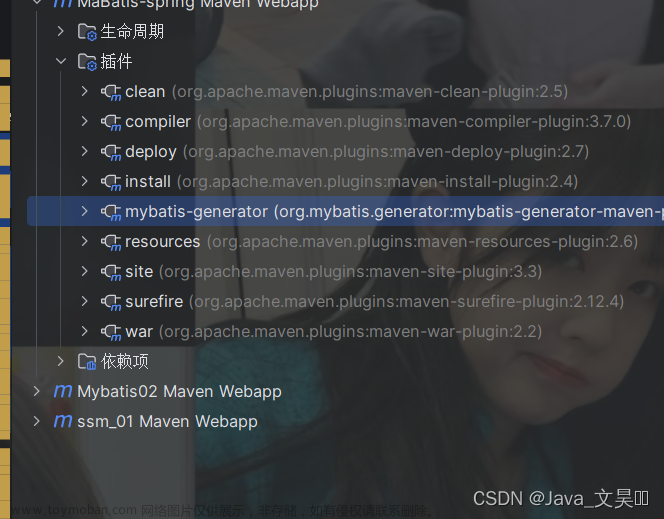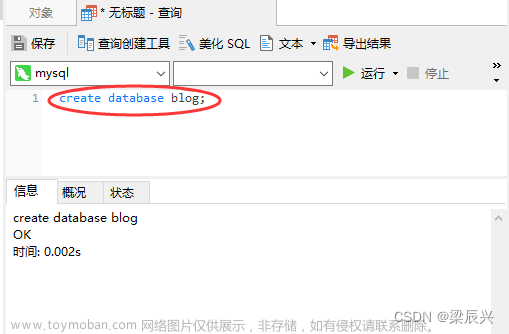前言
为了巩固所学的知识,作者尝试着开始发布一些学习笔记类的博客,方便日后回顾。当然,如果能帮到一些萌新进行新技术的学习那也是极好的。作者菜菜一枚,文章中如果有记录错误,欢迎读者朋友们批评指正。
(博客的参考源码可以在我主页的资源里找到,如果在学习的过程中有什么疑问欢迎大家在评论区向我提出)
发现宝藏
前些天发现了一个巨牛的人工智能学习网站,通俗易懂,风趣幽默,忍不住分享一下给大家。【宝藏入口】。
一、Mybatis一般开发流程
1. 设计创建数据库表tbl_account
- 建表查询语句示例
create database spring_db;
use spring_db;
drop table if exists tbl_account;
create table tbl_account(
id int primary key auto_increment,
name varchar(20),
account varchar(20)
);
INSERT INTO tbl_account VALUES (1, 'Tom', 1000);
INSERT INTO tbl_account VALUES (2, 'Jerry', 500);
- 效果

2. 创建对应maven模块并在pom.xml导入对应坐标
<dependency>
<groupId>org.mybatis</groupId>
<artifactId>mybatis</artifactId>
<version>3.5.6</version>
</dependency>
<dependency>
<groupId>mysql</groupId>
<artifactId>mysql-connector-java</artifactId>
<version>5.1.47</version>
</dependency>
3. 创建对应实体类Account
public class Account implements Serializable {
//此处省略getter、setter和toString方法
private Integer id;
private String name;
private Double money;
}
4. 创建mybatis核心配置文件mybatis-config.xml
<?xml version="1.0" encoding="UTF-8"?>
<!DOCTYPE configuration
PUBLIC "-//mybatis.org//DTD Config 3.0//EN"
"http://mybatis.org/dtd/mybatis-3-config.dtd">
<configuration>
<properties resource="jdbc.properties"></properties>
<typeAliases>
<package name="com.itheima.domain"/>
</typeAliases>
<environments default="mysql">
<environment id="mysql">
<transactionManager type="JDBC"></transactionManager>
<dataSource type="POOLED">
<property name="driver" value="${jdbc.driver}"></property>
<property name="url" value="${jdbc.url}"></property>
<property name="username" value="${jdbc.username}"></property>
<property name="password" value="${jdbc.password}"></property>
</dataSource>
</environment>
</environments>
<mappers>
<package name="org.example.dao"></package>
</mappers>
</configuration>
5. 创建数据库表信息jdbc.properties
jdbc.driver=com.mysql.jdbc.Driver
jdbc.url=jdbc:mysql://localhost:3306/spring_db?useSSL=false
jdbc.username=root
jdbc.password=root
6. 用注解的方式创建编写mappper代理接口AccountDao(或者是一个接口对应一个mapper文件)
public interface AccountDao {
@Insert("insert into tbl_account(name,money)values(#{name},#{money})")
void save(Account account);
@Delete("delete from tbl_account where id = #{id} ")
void delete(Integer id);
@Update("update tbl_account set name = #{name} , money = #{money} where id = #{id} ")
void update(Account account);
@Select("select * from tbl_account")
List<Account> findAll();
@Select("select * from tbl_account where id = #{id} ")
Account findById(Integer id);
}
7. 创建模拟测试类APP
public class App {
public static void main(String[] args) throws IOException {
// 1. 创建SqlSessionFactoryBuilder对象
SqlSessionFactoryBuilder sqlSessionFactoryBuilder = new SqlSessionFactoryBuilder();
// 2. 加载SqlMapConfig.xml配置文件
InputStream inputStream = Resources.getResourceAsStream("mybatis-config.xml");
// 3. 创建SqlSessionFactory对象
SqlSessionFactory sqlSessionFactory = sqlSessionFactoryBuilder.build(inputStream);
// 4. 获取SqlSession
SqlSession sqlSession = sqlSessionFactory.openSession();
// 5. 执行SqlSession对象执行查询,获取结果User
AccountDao accountDao = sqlSession.getMapper(AccountDao.class);
Account ac = accountDao.findById(1);
System.out.println(ac);
// 6. 释放资源
sqlSession.close();
}
}
- 模拟测试类运行结果

9. 文件结构参考

二、spring整合mybatis思路分析
1. 我们知道spring的特点之一就是能管理bean,那mybatis中有哪些bean是需要交给spring去管理的呢?我们可以将mybatis的示例运行程序APP分为以下几个部分,通过观察我们可以发现主要有如下几个对象:SqlSessionFactory、SqlSession、AccountDao

- 虽然AccountDao是直接执行业务的,但是它不是根源上的对象,而且随着业务需求不同,造出来的对象也不一样,所以它不是最核心的对象。
- SqlSession对象是由工厂造出来的,类似于连接池,该对象实际已经造好
- 所以最核心的对象是SqlSessionFactory
2. 通过观察Mybatis的核心配置文件我们可以将其分为如下几个部分:

- 第一部分 的作用是配置加载数据库信息,有没有的区别是加载的信息是否在本配置文件获取,与SqlSessionFactory没什么关系
- 第二部分 的作用是配置Mybatis操作完后得到的数据是什么类型,是SqlSessionFactory对象中可选的一个属性
- 第三部分 dataSourcre 标签中的部分是数据库连接信息,是必须的,如果没有该内容,SqlSessionFactory无法获知操作的数据库信息
- 第三部分 transactionManager 标签中的部分是事务处理相关内容,与SqlSessionFactory也有关系,本博客暂时不做探讨
- 第四部分 是业务操作相关的,即使没有,SqlSessionFactory也能创建。但是在实际开发中,如果需要用到Mapper代理开发,就需要配置这部分内容。
3. 小结
综上考虑,spring要重点管理的mybatis中的核心对象是 SqlSessionFactory,用Spring创建出SqlSessionFactory对象和业务相关的 Mapper映射对象是我们的主要目标。
三、Spring整合Mybatis环境准备(注解开发)
- 在pom.xml文件中导入spring开发相关坐标
<dependency>
<groupId>org.springframework</groupId>
<artifactId>spring-context</artifactId>
<version>5.2.10.RELEASE</version>
</dependency>
<dependency>
<groupId>com.alibaba</groupId>
<artifactId>druid</artifactId>
<version>1.1.16</version>
</dependency>
<!--spring操作数据库-->
<dependency>
<groupId>org.springframework</groupId>
<artifactId>spring-jdbc</artifactId>
<version>5.2.10.RELEASE</version>
</dependency>
<!--spring整合mybatis-->
<dependency>
<groupId>org.mybatis</groupId>
<artifactId>mybatis-spring</artifactId>
<version>1.3.0</version>
</dependency>
2. 创建Spring核心配置类SpringConfig
@Configuration
@ComponentScan("org.example")
public class SpringConfig {
}
3. 创建业务接口AccountService
public interface AccountService {
void save(Account account);
void delete(Integer id);
void update(Account account);
List<Account> findAll();
Account findById(Integer id);
}
4. 创建对应的实现类AccountServiceImpl
@Service
public class AccountServiceImpl implements AccountService {
@Autowired
private AccountDao accountDao;
public void save(Account account) {
accountDao.save(account);
}
public void update(Account account){
accountDao.update(account);
}
public void delete(Integer id) {
accountDao.delete(id);
}
public Account findById(Integer id) {
return accountDao.findById(id);
}
public List<Account> findAll() {
return accountDao.findAll();
}
}
5. 数据库连接信息
- 创建数据库信息配置类JdbcConfig
public class JdbcConfig {
@Value("${jdbc.driver}")
private String driver;
@Value("${jdbc.url}")
private String url;
@Value("${jdbc.username}")
private String userName;
@Value("${jdbc.password}")
private String password;
@Bean
public DataSource dataSource(){
DruidDataSource ds = new DruidDataSource();
ds.setDriverClassName(driver);
ds.setUrl(url);
ds.setUsername(userName);
ds.setPassword(password);
return ds;
}
}
- 加载数据库信息properties文件
@Configuration
@ComponentScan("org.example")
@PropertySource("classpath:jdbc.properties")
public class SpringConfig {
}
- 加载数据库信息配置类
方式一:在核心配置类上加@Configuration,通过Spring核心配置类SpringConfig中的@ComponentScan注解扫描
方式二:手工导入
@Configuration
@ComponentScan("org.example")
@PropertySource("classpath:jdbc.properties")
@Import(JdbcConfig.class)
public class SpringConfig {
}
6. 文件结构预览

四、Spring整合Mybatis
1. MybatisConfig配置类
- 创建Mybatis配置类MybatisConfig(实现目标:创建SqlSessionFactoryBean)
public class MybatisConfig {
//定义bean,SqlSessionFactoryBean,用于产生SqlSessionFactory对象
@Bean
public SqlSessionFactoryBean sqlSessionFactory(DataSource dataSource){
SqlSessionFactoryBean ssfb = new SqlSessionFactoryBean();
//设置别名
ssfb.setTypeAliasesPackage("org.example.domain");
//配置数据源
ssfb.setDataSource(dataSource);
return ssfb;
}
//定义bean,返回MapperScannerConfigurer对象
@Bean
public MapperScannerConfigurer mapperScannerConfigurer(){
MapperScannerConfigurer msc = new MapperScannerConfigurer();
msc.setBasePackage("org.example.dao");
return msc;
}
}
- 加载Mybatis配置类
@Configuration
@ComponentScan("org.example")
@PropertySource("classpath:jdbc.properties")
@Import({JdbcConfig.class,MybatisConfig.class})
public class SpringConfig {
}
2. 创建模拟测试类
public class App2 {
public static void main(String[] args) {
ApplicationContext ctx = new AnnotationConfigApplicationContext(SpringConfig.class);
AccountService accountService = ctx.getBean(AccountService.class);
Account ac = accountService.findById(1);
System.out.println(ac);
}
}
3. 运行结果

4. 文件结构预览

五、小结
简单来说,Spring整合Mybatis就是在Spring开发的基础上多了一个MyBatisConfig配置文件

 文章来源:https://www.toymoban.com/news/detail-590813.html
文章来源:https://www.toymoban.com/news/detail-590813.html
总结
欢迎各位留言交流以及批评指正,如果文章对您有帮助或者觉得作者写的还不错可以点一下关注,点赞,收藏支持一下。
(博客的参考源码可以在我主页的资源里找到,如果在学习的过程中有什么疑问欢迎大家在评论区向我提出)文章来源地址https://www.toymoban.com/news/detail-590813.html
到了这里,关于Spring 整合 Mybatis -- Spring入门(七)的文章就介绍完了。如果您还想了解更多内容,请在右上角搜索TOY模板网以前的文章或继续浏览下面的相关文章,希望大家以后多多支持TOY模板网!












